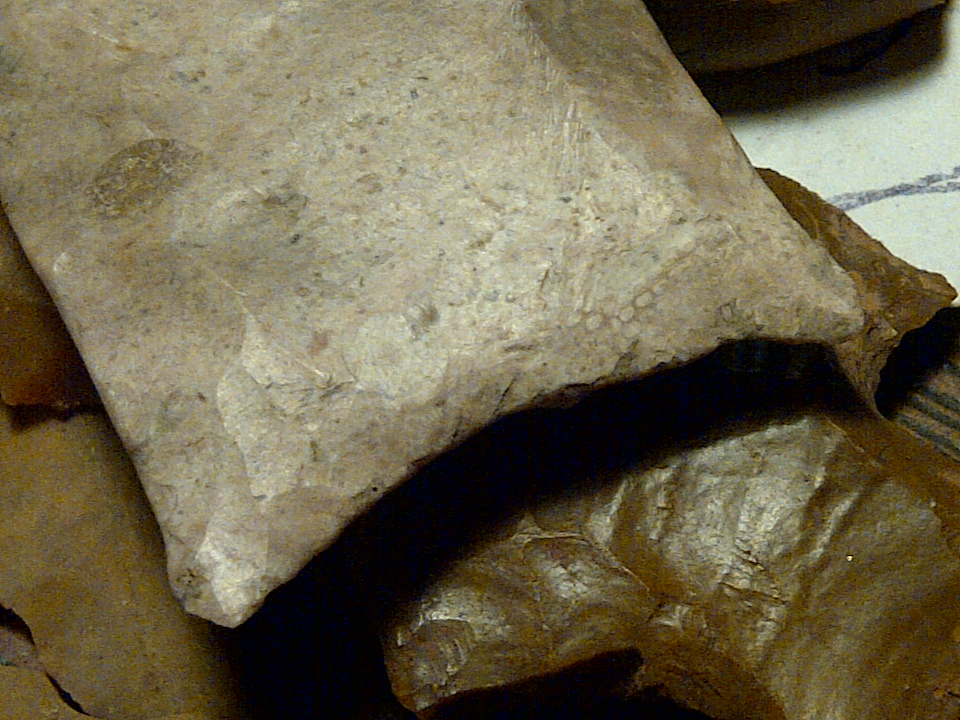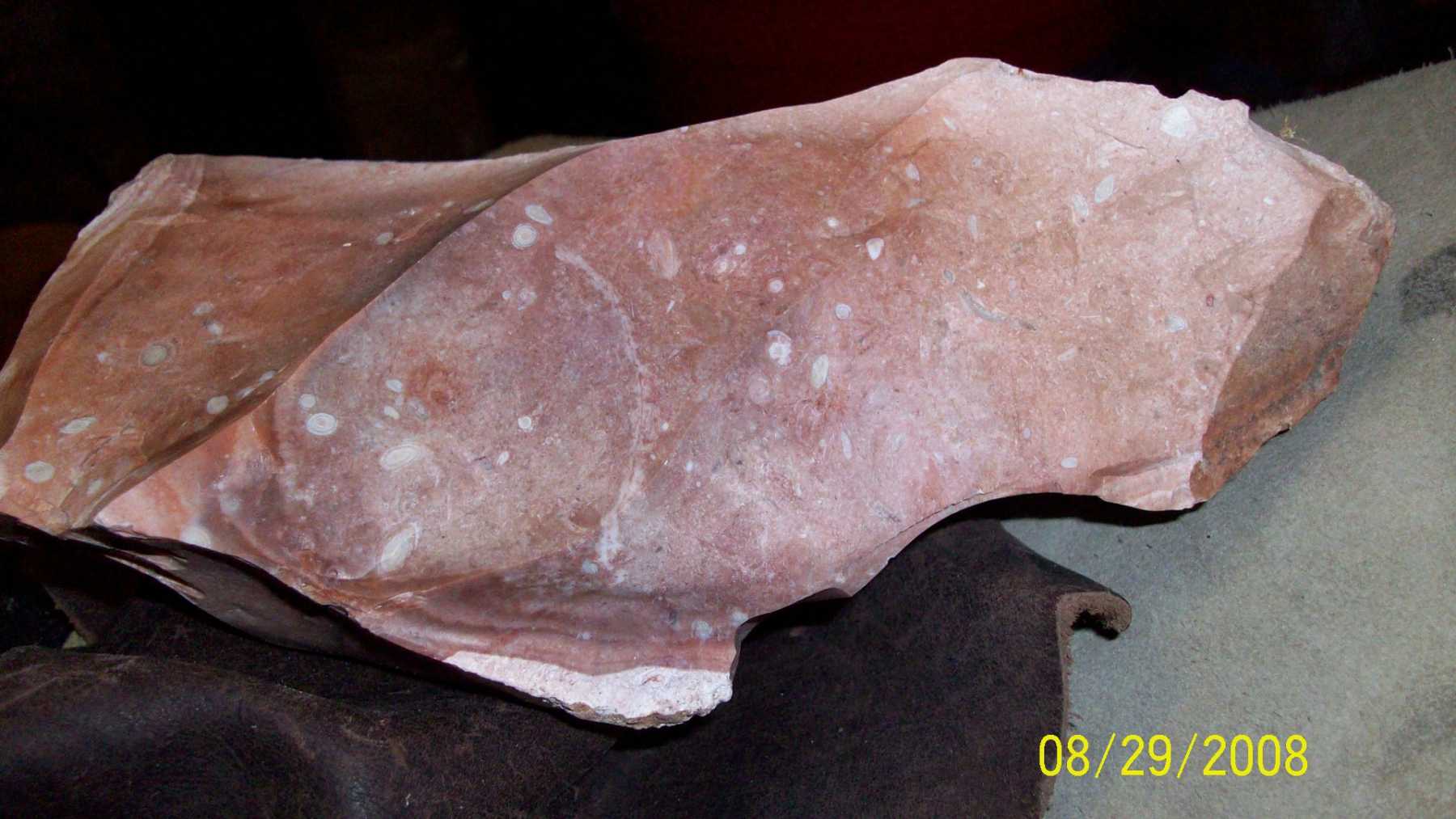Florence-A (Kay County), -B, -C & -D Cherts (Kansas & Oklahoma)
[expanded by painshill]
“Florence Chert” is found throughout the Permian Limestone Formations in the Flint Hills stretching from eastern Kansas to north-central Oklahoma. The sub-division into four distinct types: Florence-A (also known as Kay County Chert), Florence-B, Florence-C and Florence-D is a relatively recent archaeological/geological distinction. The principal outcrop for Florence-A is in Oklahoma; and for Florence B, C and D in Kansas… but not exclusively so.
Historically, the Flint Hills area was known as the Bluestem Pastures or Blue Stem Hills and, today, as the Osage Hills or simply “The Osage”. The hills extend from Marshall and Washington counties (KS) in the north to Cowley County (KS) and Kay and Osage counties (OK) in the south, and from Geary to Shawnee counties (KS) west to east.
As the limestone near the surface of these hills has been eroded and dissolved by the actions of water, the chert beds have become exposed across tens of thousands of square miles leaving most of the hill-tops covered in a clayey soil full of chert fragments, nodules and gravel.
Florence-A Chert (Kay County Chert)
Florence-A is the southernmost identifiable variant of the Florence cherts and takes its alternative name – Kay County Chert – from one of the main outcrops in north-central Oklahoma. In its natural form, it has a butterscotch colour with a yellowish hue, coarse banding in the outer portions of nodules, areas of fine wavy banding that resemble fingerprints and the nodules usually have a pale grey interior. The material was widely heat-treated in prehistoric times, which turns the yellowish portions a dark pink-red colour.
It’s also characterised by the presence of small oval fossil fusilinid fossils measuring a few millimetres in length. They’re extinct marine protozoan Foraminifera.
Image here from Artifacts of Kansas website (Wichita State University):
http://www.ksartifacts.info/3C%20Typ...orence%20A.jpg
[Additional pictures from The Office of the State Archaeologist - University of Iowa website]:

There’s also a neat animated presentation about the material here:
Florence-B Chert
Florence-B is found in the southern Flint Hills and mainly in Kansas. Its use for artefacts is most commonly seen in sites east of Wichita, Kansas. It’s a dense material, ranging in colour from a fairly dark grey to brown and sometimes has randomly-scattered white blobs and streaks of remnant algal fossils. It may take on reddish-pink hues after heat-treatment.
Image here from Artifacts of Kansas website (Wichita State University):
http://www.ksartifacts.info/3C%20Typ...orence%20B.jpg
[Additional pictures from The Office of the State Archaeologist - University of Iowa website]:

Florence-C Chert
Florence-C is the most common variant, outcropping principally in Kansas, although not as widely exploited as Florence-A and –B. It occurs in a range of blue-grey colourations and typically has numerous white flecks of fragmentary fossils such as bryozoans and sponge spicules. The colouration is not changed by heat-treatment
Image here from Artifacts of Kansas website (Wichita State University):
http://www.ksartifacts.info/3C%20Typ...0C%20chert.jpg
Florence-D Chert
Florence-D has the most northerly distribution, with the main outcrops north of the Kansas River in Kansas. It usually has a range of blue-grey colourations with paler bands and is characterised by dark blue banding in the outer areas of the nodules. Heat treatment has little or no effect on the colouration. Although not as widely exploited as Florence-A or –B, end scrapers made from this material have a wide distribution.
Image here from Artifacts of Kansas website (Wichita State University):
http://www.ksartifacts.info/3C%20Typ...0D%20chert.jpg
Florence-A Chert

Florence-A Chert, heat treated:

[expanded by painshill]
“Florence Chert” is found throughout the Permian Limestone Formations in the Flint Hills stretching from eastern Kansas to north-central Oklahoma. The sub-division into four distinct types: Florence-A (also known as Kay County Chert), Florence-B, Florence-C and Florence-D is a relatively recent archaeological/geological distinction. The principal outcrop for Florence-A is in Oklahoma; and for Florence B, C and D in Kansas… but not exclusively so.
Historically, the Flint Hills area was known as the Bluestem Pastures or Blue Stem Hills and, today, as the Osage Hills or simply “The Osage”. The hills extend from Marshall and Washington counties (KS) in the north to Cowley County (KS) and Kay and Osage counties (OK) in the south, and from Geary to Shawnee counties (KS) west to east.
As the limestone near the surface of these hills has been eroded and dissolved by the actions of water, the chert beds have become exposed across tens of thousands of square miles leaving most of the hill-tops covered in a clayey soil full of chert fragments, nodules and gravel.
Florence-A Chert (Kay County Chert)
Florence-A is the southernmost identifiable variant of the Florence cherts and takes its alternative name – Kay County Chert – from one of the main outcrops in north-central Oklahoma. In its natural form, it has a butterscotch colour with a yellowish hue, coarse banding in the outer portions of nodules, areas of fine wavy banding that resemble fingerprints and the nodules usually have a pale grey interior. The material was widely heat-treated in prehistoric times, which turns the yellowish portions a dark pink-red colour.
It’s also characterised by the presence of small oval fossil fusilinid fossils measuring a few millimetres in length. They’re extinct marine protozoan Foraminifera.
Image here from Artifacts of Kansas website (Wichita State University):
http://www.ksartifacts.info/3C%20Typ...orence%20A.jpg
[Additional pictures from The Office of the State Archaeologist - University of Iowa website]:
There’s also a neat animated presentation about the material here:
Florence-B Chert
Florence-B is found in the southern Flint Hills and mainly in Kansas. Its use for artefacts is most commonly seen in sites east of Wichita, Kansas. It’s a dense material, ranging in colour from a fairly dark grey to brown and sometimes has randomly-scattered white blobs and streaks of remnant algal fossils. It may take on reddish-pink hues after heat-treatment.
Image here from Artifacts of Kansas website (Wichita State University):
http://www.ksartifacts.info/3C%20Typ...orence%20B.jpg
[Additional pictures from The Office of the State Archaeologist - University of Iowa website]:
Florence-C Chert
Florence-C is the most common variant, outcropping principally in Kansas, although not as widely exploited as Florence-A and –B. It occurs in a range of blue-grey colourations and typically has numerous white flecks of fragmentary fossils such as bryozoans and sponge spicules. The colouration is not changed by heat-treatment
Image here from Artifacts of Kansas website (Wichita State University):
http://www.ksartifacts.info/3C%20Typ...0C%20chert.jpg
Florence-D Chert
Florence-D has the most northerly distribution, with the main outcrops north of the Kansas River in Kansas. It usually has a range of blue-grey colourations with paler bands and is characterised by dark blue banding in the outer areas of the nodules. Heat treatment has little or no effect on the colouration. Although not as widely exploited as Florence-A or –B, end scrapers made from this material have a wide distribution.
Image here from Artifacts of Kansas website (Wichita State University):
http://www.ksartifacts.info/3C%20Typ...0D%20chert.jpg
Florence-A Chert

Florence-A Chert, heat treated:

